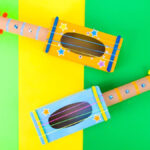The D major chord is a cornerstone for anyone learning guitar. It’s one of the first chords many guitarists learn, and for good reason: it’s incredibly versatile and appears in countless songs across genres. From U2’s anthemic “Desire” to Demi Lovato’s hit “Let It Go” and The Cars’ classic “My Best Friend’s Girl“, the d guitar chord is a fundamental building block. Adding this chord to your skills will unlock a vast repertoire of songs and accelerate your musical journey.
Let’s break down how to play this essential chord, explore a useful alternative version, and provide tips to help you master it efficiently.
How to Play the Open D Guitar Chord
The most common way to play the D major chord is in the open position. This is often the first version learners encounter because it utilizes open strings and is relatively straightforward to finger.
Here’s how to form the open D chord:
- Place your index finger on the 2nd fret of the G string (that’s the 3rd string from the thickest).
- Position your middle finger on the 2nd fret of the high E string (the thinnest string, or 1st string).
- Use your ring finger to fret the 3rd fret of the B string (the 2nd string).
Once your fingers are in place, strum downwards across the top four strings – D, G, B, and high E. Let the notes ring out clearly to hear the full, bright sound of the D major chord. Ensure you’re only strumming from the D string downwards to avoid unwanted notes from the lower strings.
Tips and Common Challenges for the D Chord
Beginner guitarists often face a couple of key challenges when learning the d guitar chord: accurately forming the chord shape and preventing unwanted string muting.
One effective practice technique to solidify your d guitar chord fingering is to practice transitioning between the D chord and other common chords like the G major chord or the A major chord. These chords frequently appear together in song progressions, making this a musically relevant exercise. Try this simple routine: strum the d guitar chord for four counts, then switch smoothly to a G or A chord for four counts, and then return to the d guitar chord. Repeat this to build muscle memory and improve your chord changes.
String muting, particularly of the lower E and A strings, is another common hurdle. A helpful trick is to gently wrap your thumb around the guitar neck and lightly touch the low E string. This dampens the string, preventing it from ringing out when you strum. While accidentally hitting the A string (5th string) isn’t as problematic – as A is part of the D major chord – you’ll eventually want to mute both the low E and A strings for a cleaner D chord sound, allowing the root D note to resonate clearly.
Improving your strumming accuracy is crucial. Initially, focus on slow, deliberate strums, ensuring you only hit the intended four strings. Clean playing develops with patience and consistent practice. Don’t rush the process; accuracy is more important than speed in the beginning.
The Barre Chord Alternative for the D Major Chord
Beyond the open position, another valuable way to play the d guitar chord is using a barre chord. A barre chord involves using one finger to press down multiple strings simultaneously. While barre chords can be challenging for beginners due to the finger strength and dexterity required, learning them is a worthwhile long-term investment. Barre chords are movable shapes, meaning once you master a barre chord shape, you can play the same chord shape at different positions on the fretboard to create different chords.
To play the D major barre chord in the 5th position:
- Place your index finger across all six strings at the 5th fret. This is the “barre”.
- Use your ring finger to fret the 7th fret of the D string (4th string).
- Position your middle finger on the 7th fret of the G string (3rd string).
- Place your pinky finger on the 7th fret of the B string (2nd string).
For this barre chord version, strum downwards from the A string (5th string). The root note for this voicing is on the A string. This variation demands more finger strength and flexibility, especially in your ring and pinky fingers to press down multiple strings cleanly. Don’t be discouraged if it sounds buzzy or muted initially. Electric guitars, with their lighter string tension, often make barre chords slightly easier to play.
The open position d guitar chord is a foundational shape, alongside chords like C, A, G, and E major. You’ll encounter the D chord constantly as you learn more songs. While mastering clean and quick transitions to and from the d guitar chord takes practice, with patience and persistence, it will become an essential part of your guitar playing.
To expand your chord vocabulary, explore resources like Fender Play’s chord library to discover various chord types and helpful mastery tips.
If you’re ready to take your guitar journey further, consider signing up for a free Fender Play trial for structured lessons and a wealth of musical knowledge.

